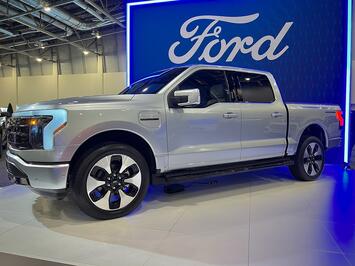
How bad is the EV business? Yesterday afternoon, Ford Motor Company reported that the operating loss it incurred on its EV business in 2023 exceeded its total profit for the year.
That shocking fact comes directly from the company’s earnings report, which carried the headline, “Ford+ Delivers Solid 2023...” The Dearborn-based auto giant had an operating loss (also known as EBIT, or earnings before interest and taxes) of $4.7 billion on its EV business last year. Meanwhile, the company reported net income (profit) of just $4.3 billion, on revenue of $176 billion. The company also reported operating income, or what it called “adjusted EBIT,” of $10.4 billion.
Calculating the company’s per-EV operating loss requires only a bit of simple division. The company sold 72,608 EVs last year and had an EBIT loss of $4.7 billion in its “Model e” segment. Thus, the auto giant lost a knee-buckling $64,731 for each EV it sold in 2023. To put that $64,731 per-vehicle loss in perspective, a top-of-the-line Mustang Mach-E listed on the website of a large Ford dealership here in Austin (see below) is selling for $66,615.
The company said the $4.7 billion loss reflected “an extremely competitive pricing environment, along with strategic investments in the development of clean-sheet, next-generation EVs.” The $4.7 billion loss is far higher than the $3 billion loss Ford projected back in March. Further, it’s more than double the $2.2 billion loss it recorded in the EV segment in 2022. Thus, in the last two years alone, the company has lost nearly $7 billion on its foray into fully electric automobiles. Recall that, as I reported here last July, the company has plans to spend $50 billion on EVs.
Given the company’s 2023 results, it’s clear that Ford’s headlong plunge into the EV market has been an unmitigated disaster and that the company would be far more profitable had it ignored the EV fad. Of course, the company tried to put a positive spin on its EV results, noting that EV sales rose by 18% last year. But those sales must be put into context. In 2023, Ford sold 750,789 F-Series trucks. Thus, the auto giant sold more than 10 times as many conventionally powered trucks as EVs (72,608).
Warnings about the company’s failing EV business have been coming for months. In December, the automaker announced it was slashing production of its F-150 Lightning in half, from 3,200 trucks per week to 1,600 per week, as part of an effort “to match Lightning production to customer demand.” On January 19, the company said it was cutting production of Lightning even further because, as Reuters reported, “demand for EVs has been lower than expected.”
What should be particularly worrisome for investors — and for the company’s CEO, Jim Farley — is that Ford’s EV losses aren’t falling, they are rising. Indeed, those losses doubled between the first quarter and fourth quarter of 2023. Ford’s first-quarter EV operating loss was $722 million. In the second quarter, it was $1.1 billion. In the third quarter, it was $1.3 billion, and in the fourth quarter, Ford’s EV operating loss hit $1.57 billion.
Read the rest of this piece at Robert Bryce Substack.
Robert Bryce is a Texas-based author, journalist, film producer, and podcaster. His articles have appeared in a myriad of publications including the Wall Street Journal, New York Times, Forbes, Time, Austin Chronicle, and Sydney Morning Herald.
Photo: Ford F-150 Lightning on display at the DeVos Place Convention Center in Grand Rapids, Michigan during the 2022 Michigan International Autoshow, in Public Domain.












